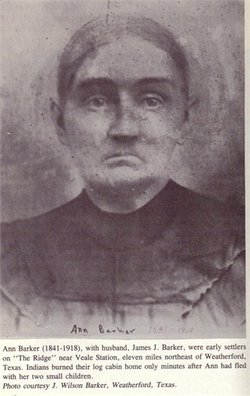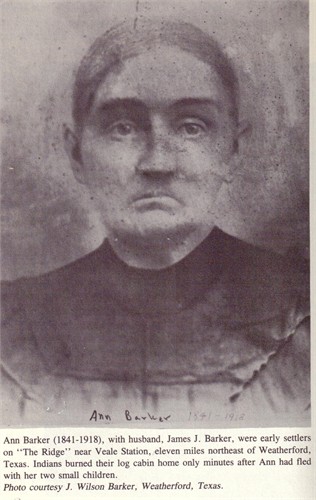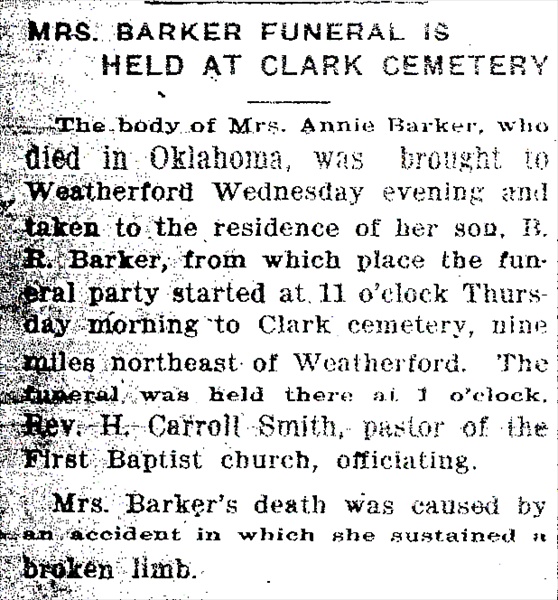year old grand niece.
"To Jennifer Ann Barker
By her great aunt Bess Ann"
"Dear Little Jennifer Ann, now just two years old. How I wish you would
have known your little pioneer "Indian Fightin" Great Great Grandmother
Ann, as I did when I was a little girl. I remember her as a small woman,
already old but very lively still, dressed always in black with a black and
white checked apron decorated in cross stitch and on her head a black
kerchief tied corner-wise with the point in back. peasant fashion. Her hair
was always parted in the middle and combed smoothly back to a bun low on
the back of her neck. Her apron had a pocket which she kept tobacco rolled
in a black handkerchief for chewing. All the elderly woman of her community
smoked clay pipes or chewed tobacco. Their lives were hard in pioneer times
and often they had to help their men folk defend their homes against
Indians, so the tobacco probably helped them to be brave.
Your Great Great Grandmother Ann was born June 14, 1841. Your Father
"James" gets his name from her husband and your great great grandfather,
James J. Barker, known as "Jim" Barker. James J. Barker was born December
7, 1834. They were probably born in Missouri, because we know they came
from Joplin, Missouri, to Parker county, Texas, during pioneer and Indian
times there. They had twelve children named as follows: Mary, William,
Martha, Nancy, Marion, Jasper, Robert, Barney (your great grandfather),
James, Frank, Samuel and Ann.
James J Barker owned considerable land in Parker County on "The Ridge" nine
miles north of Weatherford. His fields were outlined with rock fences which
were still in place when I was a child. Part of this land he sold to honor
a debt left by his brother, Joshua whose business failed in Weatherford. (
this same Joshua was one of the first business men, City Alderman, and
first sheriff of Weatherford).
The first home which Jim built on his land was of logs and it was burned by
the Indians.(I have a story to tell you about this.) The second home was
built out lumber, hauled in over long distances by oxen. It was still
standing when I was a little girl and your Great Great Grandmother Ann
lived there alone. I will tell you my memories of this house.
James J. Barker died December 17, 1893 and Ann Barker lived on at the home
place until her last few years which she spent in our Weatherford home
until her death, January 8, 1918.
When I was a little girl like you, Jennifer Ann, I used to spend as much
time as I could with my grandmother An ; and I remember, even today, every
detail of her little house, inside and out. She had a large fireplace which
she used for all her cooking. It had an iron crane extending out from the
side, and hanging on this were two kettles and an iron tea kettle. On the
hearth at one side was the dutch oven where she baked her biscuits,
cornbread and cakes. I remember a birthday cake which she baked for me when
I was three or four years old. She would put live coals on the lid and
coals underneath the dutch oven. If she cooked sweet potatoes, she baked
them in the hot ashes. If she was going to cook turnips in the winter time,
we would walk through the snow to the hay attack and dig them out from deep
in the hay where she had stored them for the winter. The turnips would go
into one of the two iron pots over the fire. Her soda she kept in a big
covered wooden bucket. The inside walls of the little house were snowy
white with whit wash and her planked floors were snowy white because she
scrubbed them with ashes.
Grandmother Ann taught me how to make corn-cob dolls to play with. We would
start with a whole ear of corn, shell off the corn and outer shucks, then
cut short and slit the remaining inner shucks to make hair. We would make
eyes nose and mouth with a piece if charcoal, and then dress the doll with
scrapes of material that grandmother saved for her quilts. She would take
with her to gather horehound growing wild and then I would watch her make
horehound candy for coughs. Also I would watch with great interest how she
would cook off her lard in a great iron pot in the yard, and how she would
make soap in this pot, first making her lye from ashes.
One memory that stands out in my mind is a walk I had of several miles with
grandmother. We were going to the pioneer Clark Cemetery where grandfather
Jim was buried. In our path there suddenly appeared a copperhead snake
which grandmother Ann soon dispatched with a walking stick which she
carried. In this cemetery are the graves of both Jim and Ann Barker as well
as many of their descendants.
And now Jennifer Ann, I have two stories to tell you about your Great Great
Grandparents, Ann and Jim Barker, and the Indians, as Follows:
" Ann's adventures with the Indians"
News came to the settlement that the commanche Indians were on a raid. As
always the men banded together and started out to find the Indians, do
battle, and run them out of the country, The women and children were
supposed to leave at once and gather at " Wards Fort" for protection. This
fort was merely the home of a man named Ward who was crippled but was very
good with his gun, and with the help of the woman could fight off the
Indians.
However, Ann had a mind of her own and was brave, so she decided to wait
until she milk her cow in the late afternoon. Then she , her mother (Great
Grandmother Teeters), and the two babies would make their way to the fort.
Just before sun down Ann started out to drive up her cow for the milking.
As she walked she could see the grass moving off to the side, and she
noticed that an Indian was following her. Then she noticed smoke pluming up
from a ravine in the distance and knew that the Indians were there cooking
supper. However, Ann continued on her way and pretended not to know the
Indian was crawling along in thew grass watching her. Still pretending, she
drove her cow home, and then went into the house to wait for darkness so
they could escape to the fort.
Inside the house Ann dressed herself in a mans coat and hat and loaded her
gun. When it was good dark she came out of the house trailed by her mother
carrying the two babies. In the darkness Ann ran into one of the gate posts
and thought it was an Indian. She started screaming and ran for the house
with her mother trying to catch her and stop the her noise. Finally things
quilted down and they slipped away from the house, on their way at last to
"Wards Fort". Before they had gone very far they could see their house in
flames with the Indians dancing round about, but they escaped with their
lives.
To this day you can find the spot where the house burned by the Indians
once stood. In a pasture near a stream you can find stones from the fallen
chimney and foundations, all showing signs of the fire; and the hearth
stones are still in place. Once in the spring I visited this pasture during
bluebonnet season with my father, Barney Barker; and we found the
bluebonnets were of a deeper hue where the pioneer house once stood.
"Jim Barker and the Indians"
One day Jim Barker was out alone on horseback looking for some horses which
he thought had strayed, or else had been stolen by the Indians. Suddenly he
spied a band of Indians in a valley just below. Luckily the Indians had not
seen him yet; so he slipped away and rode to the back side of the ridge
overlooking the valley. from there he came riding fast to the top of the
ridge. Then looking back down the back side he waved and yelled as though
he were bringing up a band of settlers to fight the Indians. The trick
worked and the Indians raced away; and Jim had one his one man battle."
year old grand niece.
"To Jennifer Ann Barker
By her great aunt Bess Ann"
"Dear Little Jennifer Ann, now just two years old. How I wish you would
have known your little pioneer "Indian Fightin" Great Great Grandmother
Ann, as I did when I was a little girl. I remember her as a small woman,
already old but very lively still, dressed always in black with a black and
white checked apron decorated in cross stitch and on her head a black
kerchief tied corner-wise with the point in back. peasant fashion. Her hair
was always parted in the middle and combed smoothly back to a bun low on
the back of her neck. Her apron had a pocket which she kept tobacco rolled
in a black handkerchief for chewing. All the elderly woman of her community
smoked clay pipes or chewed tobacco. Their lives were hard in pioneer times
and often they had to help their men folk defend their homes against
Indians, so the tobacco probably helped them to be brave.
Your Great Great Grandmother Ann was born June 14, 1841. Your Father
"James" gets his name from her husband and your great great grandfather,
James J. Barker, known as "Jim" Barker. James J. Barker was born December
7, 1834. They were probably born in Missouri, because we know they came
from Joplin, Missouri, to Parker county, Texas, during pioneer and Indian
times there. They had twelve children named as follows: Mary, William,
Martha, Nancy, Marion, Jasper, Robert, Barney (your great grandfather),
James, Frank, Samuel and Ann.
James J Barker owned considerable land in Parker County on "The Ridge" nine
miles north of Weatherford. His fields were outlined with rock fences which
were still in place when I was a child. Part of this land he sold to honor
a debt left by his brother, Joshua whose business failed in Weatherford. (
this same Joshua was one of the first business men, City Alderman, and
first sheriff of Weatherford).
The first home which Jim built on his land was of logs and it was burned by
the Indians.(I have a story to tell you about this.) The second home was
built out lumber, hauled in over long distances by oxen. It was still
standing when I was a little girl and your Great Great Grandmother Ann
lived there alone. I will tell you my memories of this house.
James J. Barker died December 17, 1893 and Ann Barker lived on at the home
place until her last few years which she spent in our Weatherford home
until her death, January 8, 1918.
When I was a little girl like you, Jennifer Ann, I used to spend as much
time as I could with my grandmother An ; and I remember, even today, every
detail of her little house, inside and out. She had a large fireplace which
she used for all her cooking. It had an iron crane extending out from the
side, and hanging on this were two kettles and an iron tea kettle. On the
hearth at one side was the dutch oven where she baked her biscuits,
cornbread and cakes. I remember a birthday cake which she baked for me when
I was three or four years old. She would put live coals on the lid and
coals underneath the dutch oven. If she cooked sweet potatoes, she baked
them in the hot ashes. If she was going to cook turnips in the winter time,
we would walk through the snow to the hay attack and dig them out from deep
in the hay where she had stored them for the winter. The turnips would go
into one of the two iron pots over the fire. Her soda she kept in a big
covered wooden bucket. The inside walls of the little house were snowy
white with whit wash and her planked floors were snowy white because she
scrubbed them with ashes.
Grandmother Ann taught me how to make corn-cob dolls to play with. We would
start with a whole ear of corn, shell off the corn and outer shucks, then
cut short and slit the remaining inner shucks to make hair. We would make
eyes nose and mouth with a piece if charcoal, and then dress the doll with
scrapes of material that grandmother saved for her quilts. She would take
with her to gather horehound growing wild and then I would watch her make
horehound candy for coughs. Also I would watch with great interest how she
would cook off her lard in a great iron pot in the yard, and how she would
make soap in this pot, first making her lye from ashes.
One memory that stands out in my mind is a walk I had of several miles with
grandmother. We were going to the pioneer Clark Cemetery where grandfather
Jim was buried. In our path there suddenly appeared a copperhead snake
which grandmother Ann soon dispatched with a walking stick which she
carried. In this cemetery are the graves of both Jim and Ann Barker as well
as many of their descendants.
And now Jennifer Ann, I have two stories to tell you about your Great Great
Grandparents, Ann and Jim Barker, and the Indians, as Follows:
" Ann's adventures with the Indians"
News came to the settlement that the commanche Indians were on a raid. As
always the men banded together and started out to find the Indians, do
battle, and run them out of the country, The women and children were
supposed to leave at once and gather at " Wards Fort" for protection. This
fort was merely the home of a man named Ward who was crippled but was very
good with his gun, and with the help of the woman could fight off the
Indians.
However, Ann had a mind of her own and was brave, so she decided to wait
until she milk her cow in the late afternoon. Then she , her mother (Great
Grandmother Teeters), and the two babies would make their way to the fort.
Just before sun down Ann started out to drive up her cow for the milking.
As she walked she could see the grass moving off to the side, and she
noticed that an Indian was following her. Then she noticed smoke pluming up
from a ravine in the distance and knew that the Indians were there cooking
supper. However, Ann continued on her way and pretended not to know the
Indian was crawling along in thew grass watching her. Still pretending, she
drove her cow home, and then went into the house to wait for darkness so
they could escape to the fort.
Inside the house Ann dressed herself in a mans coat and hat and loaded her
gun. When it was good dark she came out of the house trailed by her mother
carrying the two babies. In the darkness Ann ran into one of the gate posts
and thought it was an Indian. She started screaming and ran for the house
with her mother trying to catch her and stop the her noise. Finally things
quilted down and they slipped away from the house, on their way at last to
"Wards Fort". Before they had gone very far they could see their house in
flames with the Indians dancing round about, but they escaped with their
lives.
To this day you can find the spot where the house burned by the Indians
once stood. In a pasture near a stream you can find stones from the fallen
chimney and foundations, all showing signs of the fire; and the hearth
stones are still in place. Once in the spring I visited this pasture during
bluebonnet season with my father, Barney Barker; and we found the
bluebonnets were of a deeper hue where the pioneer house once stood.
"Jim Barker and the Indians"
One day Jim Barker was out alone on horseback looking for some horses which
he thought had strayed, or else had been stolen by the Indians. Suddenly he
spied a band of Indians in a valley just below. Luckily the Indians had not
seen him yet; so he slipped away and rode to the back side of the ridge
overlooking the valley. from there he came riding fast to the top of the
ridge. Then looking back down the back side he waved and yelled as though
he were bringing up a band of settlers to fight the Indians. The trick
worked and the Indians raced away; and Jim had one his one man battle."
Family Members
Sponsored by Ancestry
Advertisement
Records on Ancestry
Advertisement



















